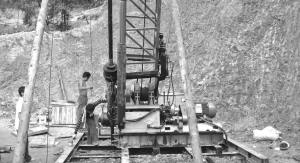A new high-grade gold vein assaying well into the double digits on New Pacific Metals’ (NUX-V, NUXFF-O) HNK property in Guangdong province, China, pushed its shares up 40% recently.
Hole ZK3001 intersected the new R1 vein, returning a 32.13-metre intersection grading 14.33 grams gold per tonne, including 8.13 metres grading 55.05 grams gold.
The hole also intersected 30 cm of the V9 vein, grading 9.08 grams gold.
After the results were released, New Pacific shares jumped 80 to $2.80 apiece on a trading volume of 313,000 shares — the biggest trading volume the company has seen in months.
The R1 vein was intersected while the company was testing the limits of the V9 vein. R1 is located about 120 metres southeast of V9, which now has a strike length of 1,500 metres and has been traced from surface to 280 metres at depth.
“We intersected V9 in three holes and as we go deeper, the grades get higher,” says New Pacific director Lou Duarte.
Duarte says the company has a lot to learn about the R1 vein.
“We have no idea the orientation of the R1 zone, right now,” Duarte says. “We’re in the very early stages of trying to fully understand.”
The company has two drills in action at the project and will continue to further define the deposit, where 19 holes totalling more than 5,520 metres have so far been drilled.
On the V9 vein, hole ZK003 intersected a 1.94-metre intersection grading 46.06 grams gold per tonne extending to 280.2 metres depth.
Drilled on a different angle than the other two holes that hit V9, ZK003 also cut through the R1 vein, returning 4.43 metres grading 99.91 grams gold.
V9 was intersected in hole ZK1001, which returned 3 metres grading 6.06 grams gold, including 50 cm grading 32.5 grams gold per tonne. Hole ZK1002 assayed 4.11 grams gold over 90 cm, reaching to 298.49 metres depth.
New Pacific has already planned 10 more holes to follow up on the latest results and will also start an underground tunnelling program of horizontal portals and decline shafts so it can access and explore the high-grade R1 vein.
V9 mineralization occurs in a thick, bedded sandstone and quartz sandstone of the upper part of the second section of Cambrian Shuishi formation. The mineralization occurs as grey-coloured silicification associated with arsenopyrite, pyrite, sphalerite and pyrrhotite. It is fine-grained and shaped as veinlets and dots.
R1 mineralization is located next to a small granodioritic stock but the extension and dipping direction are still unknown. New Pacific reports that the silicification associated with arsenopyrite and pyrite in R1 is much more intensive and wide.
New Pacific has discovered other veins as well.
“We’re finding many veins (in the area),” Duarte says. “The fact is, we have large-scale anomalies, we’ve done the drilling, we’ve traced whatwas on surface and now we’re drilling and finding that the source of these anomalies is a little bit deeper than on surface.”
Currently, the focus is on the east side of the 56-sq.-km property but New Pacific also has several targets that it will investigate later this year on the west side, which has been shown to host silver, lead and arsenic mineralization in addition to gold.
The company acquired the HNK property in 2006.
“What attracted us to this property was there were a lot of artisanal adits,” Duarte says.
He says the government stopped the artisanal operations in 2004 because they were using mercury to process the gold.
“We redid the soil geochem and found the area was good for gold and other metals,” Duarte says.
New Pacific is 23.8%-owned by Silvercorp Metals (SVM-T, SVMFF-O), and is headed by the same president and CEO, Rui Feng.
New Pacific holds 100% of HNK and another property in Guangdong, called XSK, through an agreement with Silvercorp’s wholly owned Chinese subsidiary, Yunnan Jin Chang Jiang Mining. The Chinese subsidiary holds the properties, totalling 160 sq. km, in trust for New Pacific.


Be the first to comment on "New Pacific sees lift on HNK drilling"